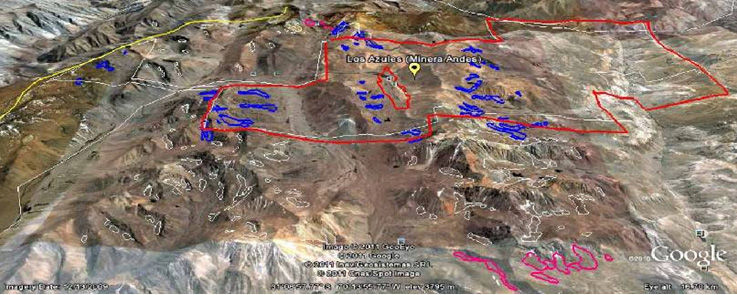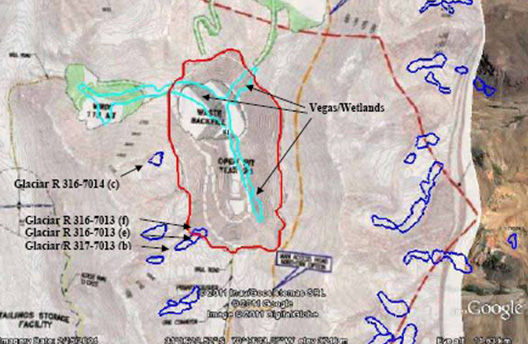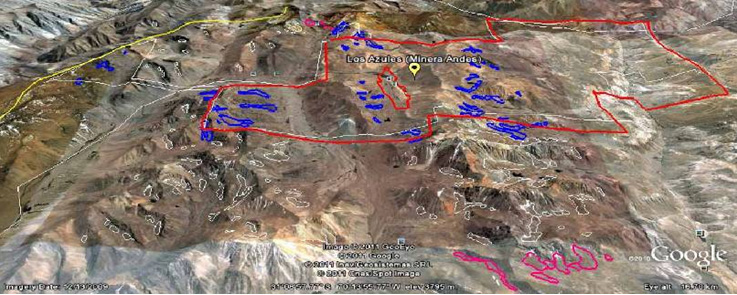Esta entrada también está disponible en: Spanish

May 14, 2012 — San Juan Argentina. Contrary to claims by McEwen Mining that its Los Azules copper project currently in exploration in Argentina, has no ice glaciers in the project area, a newly published report finds more than 200 glaciers in the project’s impact zone with 79 of these within the formal concession given to Minera Andes (the company recently acquired through a joint venture giving rise to McEwen Mining of Canada).
Several of these ice glaciers are already impacted by exploratory work and access routes and several more would be destroyed if the project continues as planned. Recent photographs also show that Minera Andes has seriously impacted rock glaciers by introducing new portions of the access road it uses to reach the project site. This would be in direct violation of both Argentina’s newly enacted National Glacier Protection Act, but would also go counter to local government legislation protecting glaciers.
The Center for Human Rights and Environment (CEDHA), of Cordoba Argentina, which also authored a similar recent report on the glacier impacts of Xstrata Copper’s El Pachón project, found 226 ice glaciers in the Los Azules project vicinity, refuting the claim on McEwen’s Mining’s website suggesting that “no ice glaciers are present in the project area”.[1]
The environmental group also found that Minera Andes’ prospect drilling took place at or adjacent to glaciers and also likely impacted permafrost areas. Both would be illegal according to the new glacier law. Official Minera Andes documentation sites that drilling companies contracted by Minera Andes reported delays and difficulties in carrying out perforation due to the presence of glacier ice, that is, exploratory work at Los Azules has drilled into glaciers in search of precious metals, which would also be against the law. The projected site for Los Azules’ Pit as well as sterile rock pile dumps that are programmed for project implementation, would also destroy glaciers.

The second image shows the project pit site (red polygon) in which there is at least one glacier visible inside of the pit (the blue polygon at bottom of the pit) and several more just south west of the pit site, but also shows fragile mountain wetland systems (light blue polygons) which would also be destroyed by the project.
The nonprofit group approached Minera Andes, with preliminary findings in 2011, and the company then agreed to a site visit with CEDHA’s technical team and glacier experts from Canada and Argentina which have contributed to CEDHA’s report.[2] But when the company reneged on the promised visit in February of 2012, and proceeded to post on its website that there were no glaciers present, CEDHA decided to publish the 85 page technical study showing the glaciers surveyed utilizing satellite images freely available on Google Earth and evidence from Minera Andes’ own Environmental Impact Study. CEDHA’s full report is didactically explained so anyone can find the glaciers for themselves on freely available and easily used internet software.
CEDHA is now exploring options to file an international complaint against McEwen Mining of Canada for its past and present impacts to glaciers, as well as to push McEwen for a redesign of its Los Azules project so as to protect the extensive ice glaciers present at the project site.
For more information contact:
Jorge Daniel Taillant
+54 9 351 507 8376
To view the report (3mb):
https://center-hre.org/wp-content/uploads/2012/05/Glaciar-Impact-Report-Los-Azules.pdf

